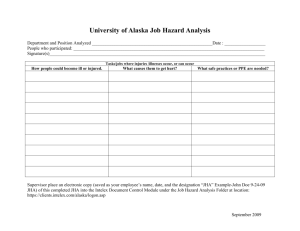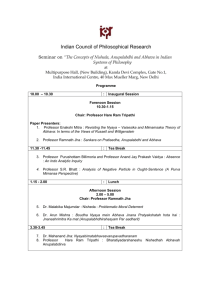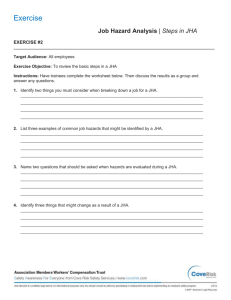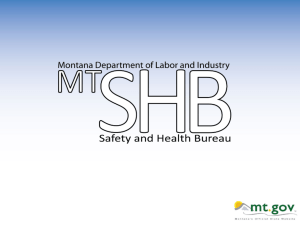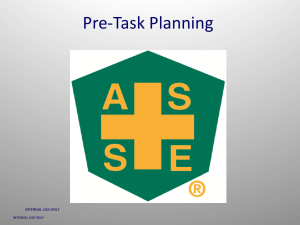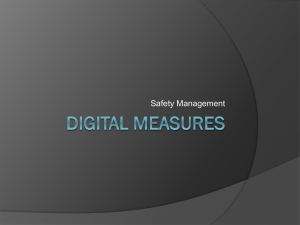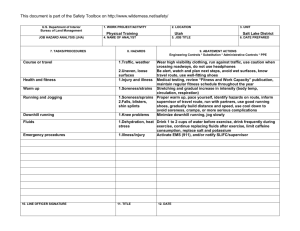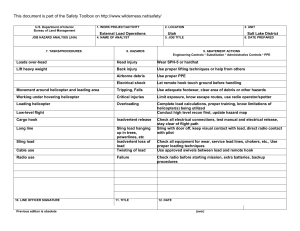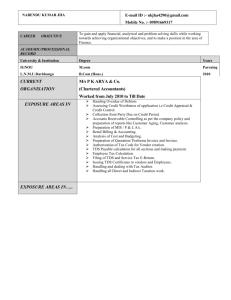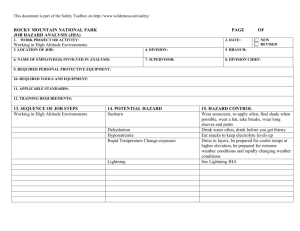an overview of job hazard analysis technique
advertisement
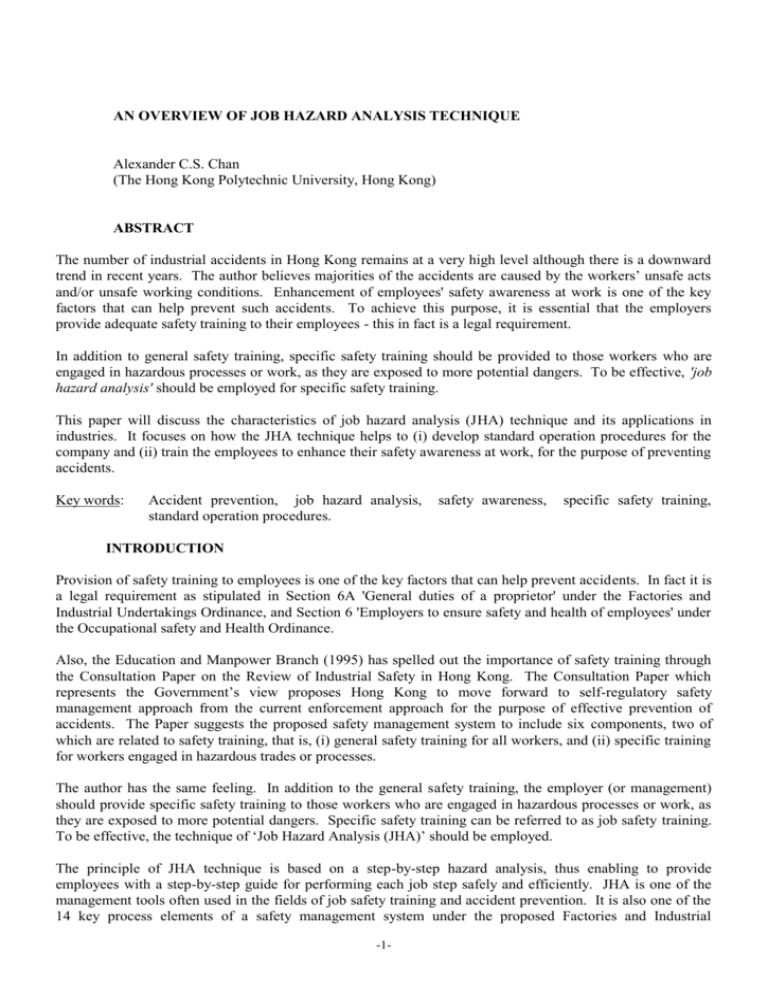
AN OVERVIEW OF JOB HAZARD ANALYSIS TECHNIQUE Alexander C.S. Chan (The Hong Kong Polytechnic University, Hong Kong) ABSTRACT The number of industrial accidents in Hong Kong remains at a very high level although there is a downward trend in recent years. The author believes majorities of the accidents are caused by the workers’ unsafe acts and/or unsafe working conditions. Enhancement of employees' safety awareness at work is one of the key factors that can help prevent such accidents. To achieve this purpose, it is essential that the employers provide adequate safety training to their employees - this in fact is a legal requirement. In addition to general safety training, specific safety training should be provided to those workers who are engaged in hazardous processes or work, as they are exposed to more potential dangers. To be effective, 'job hazard analysis' should be employed for specific safety training. This paper will discuss the characteristics of job hazard analysis (JHA) technique and its applications in industries. It focuses on how the JHA technique helps to (i) develop standard operation procedures for the company and (ii) train the employees to enhance their safety awareness at work, for the purpose of preventing accidents. Key words: Accident prevention, job hazard analysis, standard operation procedures. safety awareness, specific safety training, INTRODUCTION Provision of safety training to employees is one of the key factors that can help prevent accidents. In fact it is a legal requirement as stipulated in Section 6A 'General duties of a proprietor' under the Factories and Industrial Undertakings Ordinance, and Section 6 'Employers to ensure safety and health of employees' under the Occupational safety and Health Ordinance. Also, the Education and Manpower Branch (1995) has spelled out the importance of safety training through the Consultation Paper on the Review of Industrial Safety in Hong Kong. The Consultation Paper which represents the Government’s view proposes Hong Kong to move forward to self-regulatory safety management approach from the current enforcement approach for the purpose of effective prevention of accidents. The Paper suggests the proposed safety management system to include six components, two of which are related to safety training, that is, (i) general safety training for all workers, and (ii) specific training for workers engaged in hazardous trades or processes. The author has the same feeling. In addition to the general safety training, the employer (or management) should provide specific safety training to those workers who are engaged in hazardous processes or work, as they are exposed to more potential dangers. Specific safety training can be referred to as job safety training. To be effective, the technique of ‘Job Hazard Analysis (JHA)’ should be employed. The principle of JHA technique is based on a step-by-step hazard analysis, thus enabling to provide employees with a step-by-step guide for performing each job step safely and efficiently. JHA is one of the management tools often used in the fields of job safety training and accident prevention. It is also one of the 14 key process elements of a safety management system under the proposed Factories and Industrial -1- Undertakings (Safety Management) Regulations drafted by the Government in 1996, subsequent to the Consultation Paper (1995) feedback from the industries and academic institutions. JOB HAZARD ANALYSIS (JHA) JHA aims to looks for all of the hazards associated with a job that may affect the worker’s safety and health as well as the environment. To be effective, JHA should be applied to a job that is not too broad nor too simple regarding the nature of work. For example, oil refining and pushing a button are respectively too broad and too simple for such analysis. Lathe work, press tool work, spray painting, electric arc welding and sheet metal work are examples of the appropriate jobs that are suitable for hazard analysis using JHA. When two or more jobs are to be analysed, priorities set should be based on the following criteria: Criteria Note Frequency Jobs with a high frequency of accidents or near misses pose a significant threat to the workers’ health and safety. Pareto Principle (20/80) can be applied here to help setting priorities. Seriousness Jobs that have already produced fatalities, disabling injuries, illnesses or environmental harm, regardless of the frequency, should have a high priority. New Jobs For a new job, a thorough JHA should first be performed before any worker is assigned to it, since there is no past record to show how dangerous it is. Changes in Procedures Priority should also be given to the jobs that have undergone a change in procedure, equipment or materials. STANDARD OPERATION PROCEDURES JHA aims for accident prevention. To achieve this aim, it is important that the risk control measures developed from JHA be integrated into the work so as to form part of the standard operation procedures. Integration is a key factor of success. As said by Petersen (1978), “We do not want production and a safety program, or production and safety, or production with safety - but, rather, we want safe production." The author strongly supports this concept of 'integrated' safety. To be effective, safety must be an integral part of a company's procedures. If separate, people may only concentrate on production and forget safety steps. It is only through integration that people will not forget or miss because it has made ‘safety’ completely dissolved into the job procedures. To develop standard operation procedures for performing the job in a safe and efficient way, it is important to (i) list all the steps necessary to perform the job based on the work study, (ii) examine each job step critically for hazard identification, (iii) develop risk control measures for all the hazards so identified, and (iv) integrate the control measures with the job steps together to form standard operation procedures. An example of the standard operation procedures that have gone through the work study and JHA is given below: Job: 1. 2. 3. 4. Metal turning on a centre lathe (say, a mild steel workpiece of size 20mm diameter x 200mm long) Select the lathe that is in good working condition and equipped with all the necessary tools for the job. Check the workpiece to be turned, and remove sharp edges and burrs (if any) with a file. Before mounting the workpiece on the machine, make sure the electric power is switched off. Mount the workpiece tightly in a 3-jaw self centering chuck using the key provided, with the necessary length of the workpiece protruded from the chuck face for turning. -2- 5. Take away the key after workpiece mounting. 6. Select the appropriate cutting tool with the correct rake and clearance angles for turning mild steel (i.e. top rake 25-300, side rake 25-300, and clearance 100). 7. Adjust the cutting tool to the correct centre height. 8. Adjust the correct spindle speed for turning mild steel based on the formula: 1000S/3.14D, where S = cutting speed of material to be turned in m/min, and D = diameter of workpiece to be turned in mm In this example, the appropriate spindle speed is about 400 rpm (i.e. 1000 x 25 / 3.14 x 20). 9. Put on the machine guard for the lathe chuck. 10. Wear face shield and make sure no loose clothing, no long hair, etc. 11. Switch on the machine power. 12. Switch on the pump for cutting fluid. 13. Start a rough cut first by manual feeding of the turning tool with cutting fluid on. . . . etc. Standard operation procedures should be developed in this way to achieve a safe and efficient operation, and it is important that management should ensure these developed procedures be implemented and followed by the workers. Any deviation from the laid down procedures may lead to an accident. BASIC STEPS OF CONDUCTING JHA TECHNIQUE The author considers JHA a 5-stage process starting with selection of job and ending with production of written standard operation procedures for the job. To summarise, the five basic steps for carrying out the JHA technique are: 1. Select the appropriate job (with respect to nature of work and the priority set) for hazard analysis. 2. List all the steps necessary to perform the job (based on work study). 3. Identify all hazards associated with the job by examining every job step critically including any harm created to the environment. 4. Develop risk control measures for all the hazards so identified. 5. Integrate the risk control measures with the job steps together to form the job’s standard operation procedures (SOP), similar to the above example of metal turning. SOP can only be developed through a team of knowledgeable and experienced personnel including the work study and safety & health professionals. Figure 2 illustrates the author’s 5-step JHA model ‘SLIDI’. SELECT JOB LIST STEPS INTEGRATE TO BECOME SOP IDENTIFY HAZARDS DEVELOP SOLUTIONS Figure 2: Five-step JHA model to aim for safe and efficient operation CONCLUSIONS -3- 1. Safety training is a key process element of a safety management system that is able to enhance employees' safety awareness. In addition to the general safety training, management should provide specific safety training to those workers who are engaged in hazardous processes or work. 2. Job hazard analysis (JHA) technique is one of the management tools often used in the fields of specific safety training and accident prevention. 3. Conducting JHA requires a team effort. By involving others in the process, the possibility of overlooking an individual job step or a potential hazard, can be reduced; and so the likelihood of developing the most appropriate risk control measures can be increased. A 'JHA' team should therefore consist of knowledgeable and experienced personnel including the work study and safety & health experts, the job supervisor and the employees who perform the job. 4. JHA should be a 5-step process starting from the selection of job to production of standard operation procedures. Implementation of the standard operation procedures that have been developed on the basis of work study and JHA can achieve a safe and efficient operation. REFERENCES Education and Manpower Branch, 1995, Consultation Paper on the Review of Industrial Safety in Hong Kong, Government Printer, Hong Kong. Petersen, Dan, 1978, Techniques of Safety Management, 2nd edition, McGraw-Hill Book Company, p.27. -4-
